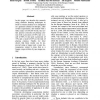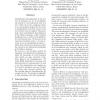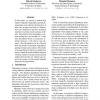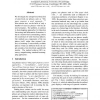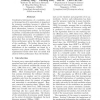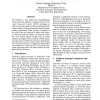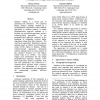ACL
2006
14 years 29 days ago
2006
In this paper, we describe the research using machine learning techniques to build a comma checker to be integrated in a grammar checker for Basque. After several experiments, and...
ACL
2006
14 years 29 days ago
2006
In this paper, we argue that n-gram language models are not sufficient to address word reordering required for Machine Translation. We propose a new distortion model that can be u...
ACL
2006
14 years 29 days ago
2006
This paper presents Archivus, a multimodal language-enabled meeting browsing and retrieval system. The prototype is in an early stage of development, and we are currently explorin...
ACL
2006
14 years 29 days ago
2006
Morphological disambiguation is the process of assigning one set of morphological features to each individual word in a text. When the word is ambiguous (there are several possibl...
ACL
2006
14 years 29 days ago
2006
In this paper, we present a method that improves Japanese dependency parsing by using large-scale statistical information. It takes into account two kinds of information not consi...
ACL
2006
14 years 29 days ago
2006
We investigate the unsupervised detection of semi-fixed cue phrases such as "This paper proposes a novel approach. . . 1" from unseen text, on the basis of only a handfu...
ACL
2006
14 years 29 days ago
2006
We investigate generalizations of the allsubtrees "DOP" approach to unsupervised parsing. Unsupervised DOP models assign all possible binary trees to a set of sentences ...
ACL
2004
14 years 29 days ago
2004
Coreferential information of a candidate, such as the properties of its antecedents, is important for pronoun resolution because it reflects the salience of the candidate in the l...
ACL
2004
14 years 29 days ago
2004
We introduce a new method for disambiguating word senses that exploits a nonlinear Kernel Principal Component Analysis (KPCA) technique to achieve accuracy superior to the best pu...
